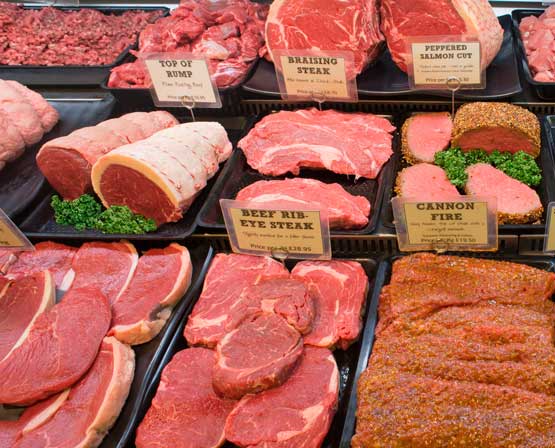Jack: A while back I decided that I wanted to dig a little deeper into grass fed beef, and find out what all the fuss was about. You hear a lot of good things – for a start, it seems that cows were meant to eat grass, not a lot of the other things people feed them (Bovine spongiform encephalopathy, anyone?).
At Tasting Britain, we’re all about supporting local farmers, and as you may/may not know, the British have a proud and distinguished history of beef and cow in all its forms (the French refer to us as ‘rostbeefs’ for a reason!). So I guess our agenda is giving some love to British beef farmers who raise happy, healthy cows – and to find out how grassfed fits into that.
Enter Andrew Shufflebotham – an expert if ever there was one. As the owner of his own herd of pedigree cattle at age 13, and a guy who’s worked on farms as far afield as Canada and Australia – Andrew has now runs the Cheerbrook Farm Shop, which recently won the award for ‘Best On-Farm Butchery’ at the FARMA Awards.
(Which sounds a little like The Oscars, but with farmers and shorter acceptance speeches :3)

Anyway, that’s some of the man’s credentials, and why you might want to care about where your beef comes from (if you don’t already?)
We wanted to find out the environmental, financial and health implications of eating beef – is it more expensive? better for you? better or worse for the environment? Does it taste different? And how can you even tell if it is grassfed afterall?
Andrew shares some wisdom…
J: Hi Andrew! Are there any health differences between grass and grain fed beef?
A: Generally, grass-fed beef contains slightly higher amounts of healthy omega-3 fats and CLA (conjugated linoleic acid) than grain-fed beef, as well as slightly less fat overall. Because the animal is consuming fresh food, there may also be various trace elements present in grass-fed beef that don’t tend to be present in grain-fed. In the context of a well-balanced diet, however, these differences are not really significant.
And are there any environmental differences?
Traditional farming methods, where animals are reared at least partly on grass, are why our countryside looks as it does with its pleasant green pastures and for me, this is an important environmental benefit of this type of farming.

It’s also the case that grain is quite energy-intensive to produce and there may be pesticides and fertilisers involved in that process, so grass-fed has environmental benefits in that way too.
Are there any other differences I may have missed?
Taste: Grass-fed beef can often have a better flavour than grain-fed beef but there are lots of other factors at play such as the breed of cattle, the type of land it’s grazed on and how it’s been hung.
Caloric content: Grass-fed beef tends to have less fat because the animal gets more exercise but then you need a certain amount of fat for the meat to be tasty and juicy so it’s not always as simple as ‘grass-fed is better.’
Appearance: Completely grass-fed beef may also have really quite yellow fat which can put a lot of consumers off as it’s not what they’re used to.

Realistically, most cattle in the UK are fed a mixture of grass, dried grass and grain depending on the time of year and their life stage.
Is there any difference in cow welfare between the two?
It’s very difficult to generalise but obviously, green pastures are the cow’s natural environment and animals reared on an entirely grain-based diet are likely to be reared in a more artificial one where they may have less space and less opportunity for natural behaviour.
Realistically, optimal animal welfare usually involves some element of grain feeding in the winter – animals are happier indoors when it’s freezing cold and driving sleet outside. And grass is scarce through the winter months – you don’t mow your lawn in the winter as it doesn’t grow, so it’s hard for cattle to get everything they need from grass and forage only all year round.
Are there any differences in price?
Grass-fed beef is generally slightly more expensive than grain-fed. This is largely because it takes longer for the cows to reach slaughtering size.
Following from the above question, is there a cheap(er/ish) way to buy grassfed?
Your local farm shop or farmers market is likely to be your best bet for good value grass-fed beef. You may be able to get a better price by buying in bulk for the freezer.

What happens when cows eat grain?
Grain is a high-starch, high-energy food – higher than grass, so cows typically fatten more quickly on this type of diet.That’s the fundamental effect of a grain diet.
Is it possible to make a typical comparison of pastured vs feedlot cattle?
I think this has been mainly covered above but typically, feedlot cattle are reared more intensively – they reach slaughtering weight faster. Because they don’t get as much exercise the meat tends to have more fat marbling through it.
Pastured animals tend to have better flavoured meat and their fat is yellower to look at due to the carotene from the grass.
Is there certification or system of verification, like with the Organic label?
The beef labelling system is a European Community (EC) wide system which applies to all fresh or frozen beef anywhere in the supply chain and is intended to provide buyers with clear, reliable information about beef provenance.

It’s not compulsory to label beef with its production method (ie grass or grain-fed), but if you do wish to label it, the claim has to be verified by the relevant authorities. The guidelines state that using a term such as grass-fed must mean, as a minimum, that the animal concerned was fed primarily on grass in the field.
Is there much regional difference in the care & feeding of English, Irish, Welsh & Scottish beef? Are some fed more grass than others, and so on?
Not really – the vast majority of beef cattle in the UK are reared on a mix of grain and grass, in varying proportions.
Does it apply to other cattle? For example – what about grain/grass fed lamb. Or Goat?
In the UK, most lambs are finished on grass before slaughtering. I believe there are slight differences in nutrient levels in grass-fed lamb along similar lines to beef and there may also be greater variations in flavour due to the greater variation in vegetation eaten by sheep. Meat from lambs grazing particularly herby areas for instance may take on a distinctive flavour from it.
Is it possible for a buyer to determine if meat is grass fed – or how much of a proportion of it is?
In short, probably not. Grass-fed beef tends to have slightly yellower fat and less marbling of fat throughout the meat, but it’s not always obvious and it would certainly be almost impossible to determine what proportion of an animal’s diet was grass.
